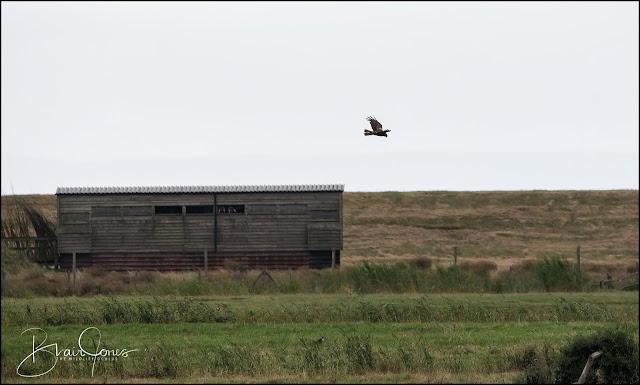A Marsh Harrier quartering and a Peregrine wadering.
With the change in the weather and the autumn passage of migrating birds gathering pace I was really looking forward to visiting my now regular birding patch at Goldcliff Lagoons. The last time I spent some time at the lagoons they were becoming akin to Death Valley with Lagoon 2 completely dried out and the other lagoons looking shockingly low. Despite this though the lagoons had been busy with lots of birds to see.
The local farmer was on the lagoons early on but there was not that many birds around for him to disturb if I am honest. I think the wildlife is probably quite used to him.
My first impression this morning was that the lagoons are looking a little better. Water levels on Lagoon 1 and 3 are improving. Lagoon 2 has some puddles but remains baked dry.
If we get some more rain this weekend then hopefully the water levels will return to normal.
You may think that with the water returning the lagoons would be full of waders. Not the case today even at high tide.
I suspect the water does not contain as much invertebrate life as it did during the drought. I imagine the low waters concentrated a great deal of invertebrate food for the birds to feast on and now after the drought they will take some time to recover.
At lagoon 1 I had a good view of two Common Sandpipers and flock of Pied Wagtails. It looked like they were feeding on insects that were flying around the mud.
At the sea wall I scanned the sea edge of the incoming tide. There was a nice show of Curlews, a couple of Whimbrels, hundreds of Shelducks and a nice flock of Oystercatchers. It was really windy and at one point a gust blew my tripod and scope over!
On my way to the sea wall hide I watched Yellow Wagtails picking off insects disturbed by a herd of cows and then grabbed a few pictures from a distance as they perched on the electric fence.
I had the sea wall hide to myself for a good few hours. My outlook from the hide for almost an hour was quite devoid of birds to watch. The highlight was a Little Egret, a couple of Gulls and Geese flying in the distance. As high tide approached things changed. Speeding in across the sea wall in a blur of motion flying low to the ground came a large flock of Common Ringed Plovers and Dunlins. They landed on a patch of mud in Lagoon 3. With the naked eye you would struggle to see them camouflaged against the mud and shallow water in the muggy overcast daylight.
As I counted them I noticed a Sanderling scurrying along with them. As a flock they behaved very similarly. They bathed, preened and then roosted pointing into the wind.
There numbers grew until there was 74 Common Ringed Plovers and 90 Dunlins. Some came and went including the Sanderling.
At high tide I got some company from some fellow birders. A Greenshank got spotted by a sharp eyed birder on the edge of the reeds and we watched a Curlew land in Lagoon 3 and 2 Little Egrets moving between lagoons but in general it was quiet.
It was eventually time to make a move so I headed back accompanied by a friendly birder who I had struck up a good conversation with in the hide. He had a great story about how stupid sheep are in Turkey which made me chuckle. He spotted a Marsh Harrier over the lagoons so we headed back for a quick look.
In hide 1 we were hoping for a better view of the Marsh Harrier and instead saw a Peregrine Falcon sat on the edge of the island. It then proceeded to fly a short distance and land in the water. Perhaps it thinks its a "wader" or its a new hunting technique. I suspect it was having a wash.
The Marsh Harrier- which turned out to a rather good looking big female began quartering the grass between lagoon 1 and 3. She afforded anyone in hide 1 or the seawall hide (hide 3) some great views - albeit from a distance.
I am not sure what she was after but she was very interested in something on the floor. At one point the Peregrine got involved.
The Marshy caused a flock of Teals some major stress and they hit the panic button hurtling in front of her in a small flock. She did not swoop upon them though and they lived to fly another day.
Watching the raptors really finished off my visit well. A little patience and time is all that is needed when its quiet and nature will come to you :)
 |
| Marsh Harrier (female) quartering in front of the Seawall hide . (Viewed from Redshank Platform) |
 |
| Female Marsh Harrier disturbing Ringed Plovers |
 |
| Peregrine Falcon at Lagoon 1 |
 |
| "Wading" Peregrine Falcon |
 |
| Can you see them? Camouflaged against the mud - Dunlins and Common Ringed Plovers |
 |
| Dunlins and Common Ringed Plovers |
 |
| Yellow Wagtails and juvenile |
 |
| Incoming Common Ringer Plovers |

